ASEAN countries will work together to boost economies hit by COVID-19
At the 36th Association of Southeast Asian Nations Summit on Friday, leaders of the 10-member bloc pledged their “strong commitment” to implementing a comprehensive recovery plan that will stabilize the regional economy while keeping COVID-19 at bay. This was one of the highlights in the ASEAN Leaders Vision Statement on a Cohesive and Responsive ASEAN: Rising Above Challenges and Sustaining Growth issued at the end of the virtual summit chaired by Vietnamese Prime Minister Nguyen Xuan Phuc.
Analysts said ASEAN’s focus on regional cooperation implies the leaders’ acknowledgment that they need to go beyond providing fiscal stimulus to their domestic economies.
“They have come to the realization that if you want to get out of COVID-19 you have to get out of it as a region,” said Mustafa Izzuddin, senior international affairs analyst at the political consultancy Solaris Strategies Singapore.
The economies of the 10 countries-Brunei, Cambodia, Indonesia, Laos, Malaysia, Myanmar, the Philippines, Singapore, Thailand and Vietnam-are interconnected, Mustafa said. As such even if one country has eradicated the virus it will be impossible for it to open up its borders and go back to business if its neighbors are still dealing with an outbreak.
The economic recovery is a collective effort, he said.
Tan Hsien Li, co-director of ASEAN Integration Through Law at the Centre for International Law, National University of Singapore, said ASEAN members usually come together to deal with major crises such as the 1997 Asian financial crisis and the severe acute respiratory syndrome outbreak in 2002.
“COVID-19 is of the same magnitude,” Tan said. “This (pandemic) will propel greater cooperation as there is the realization that nobody can go it alone.”
Venkatachalam Anbumozhi, senior economist at the Economic Research Institute for ASEAN and East Asia in Jakarta, said the summit was held at a time when the countries in the region are dealing with “severely damaged business and investor confidence” caused by COVID-19.
“Supply chain disruptions, weak demand shocks and other social distancing measures (have) affected the intraregional trade and export to other regions like the United States, Japan and European Union.”
He welcomed the ASEAN Vision Leaders Statement, noting that it shows that the 10 countries can work together to save lives and jobs.
ASEAN governments have closed borders, temporarily shut schools and businesses and promoted social distancing to stem the rise of infections. But these measures have also slowed economic activity. Trade and investment flows have been disrupted as unemployment has risen and consumer demand has fallen. The Asian Development Bank forecast Southeast Asia’s economy to contract 2.7 percent this year.
In their Vision Statement, ASEAN leaders said they will implement a comprehensive recovery plan “with a view to improving stability and resilience of the regional economy, preserving supply chain connectivity, while staying vigilant of a second wave of infections”.
List of measures
They also pledged to retain “necessary interconnectedness” in the region by encouraging business travel but without sacrificing public health; support small and medium enterprises and restore a conducive business environment.
ASEAN leaders also adopted the Hanoi Plan of Action on Strengthening ASEAN Economic Cooperation and Supply Chain Connectivity in Response to the COVID-19 Pandemic. This document listed the measures that ASEAN governments will enforce to mitigate the economic impact of the pandemic. The measures include easing the flow and transit of food, medicine and medical supplies around the region; cooperating in the production of and access to medicines and vaccines used to treat COVID-19; promoting local currency settlement to boost intraregional trade and investment flows; and refraining from imposing unnecessary non-tariff measures.
“The region is anticipating a recession for the year due to the pandemic,” Oh Ei Sun, senior fellow at the Singapore Institute of International Affairs said. “So existing initiatives such as the ASEAN Economic Community, which reduces and removes tariffs and non-tariff barriers, acquire renewed importance and must be reinvigorated.”
Oh said that it is also for this reason that ASEAN member-countries need to conclude negotiations for the Regional Comprehensive Economic Partnership, a proposed free-trade agreement expected to cover about one-third of the global economy.
ASEAN led the formation of the agreement in 2012 and was supported by six other countries: China, India, Japan, South Korea, Australia and New Zealand. If completed, it would be the largest multilateral trade deal in the world.









